Factors Influencing Clinical Decision Making and Health IT in Nursing
VerifiedAdded on 2022/08/11
|7
|2009
|41
Essay
AI Summary
This essay examines the crucial aspects of clinical decision-making in nursing, emphasizing the factors that influence nurses' judgments and the role of Health Information Technology (HIT) in enhancing patient care. It highlights the importance of effective leadership, teamwork, and continuous learning in fostering sound clinical decisions. Furthermore, the essay delves into the implementation and impact of Electronic Health Records (EHRs) as a key component of HIT, discussing its benefits such as improved efficiency, communication, and patient satisfaction. However, it also acknowledges the potential drawbacks of EHRs, including costs and the risk of technology malfunctions. The analysis concludes that while HIT offers significant advantages in healthcare, it is essential to address its limitations to ensure optimal patient outcomes. This paper is an insightful contribution to Desklib, a platform providing AI-powered study tools for students.
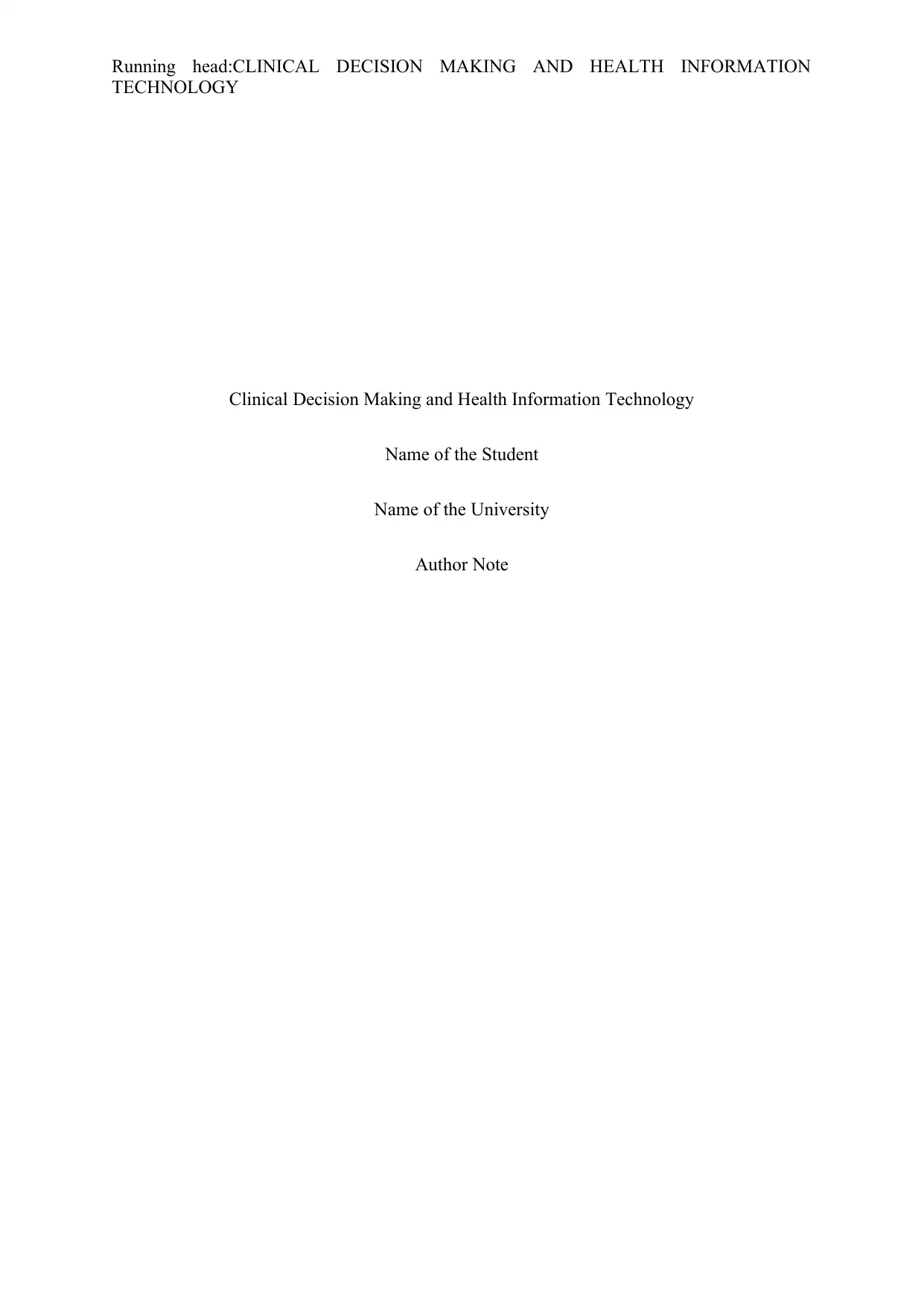
Running head:CLINICAL DECISION MAKING AND HEALTH INFORMATION
TECHNOLOGY
Clinical Decision Making and Health Information Technology
Name of the Student
Name of the University
Author Note
TECHNOLOGY
Clinical Decision Making and Health Information Technology
Name of the Student
Name of the University
Author Note
Paraphrase This Document
Need a fresh take? Get an instant paraphrase of this document with our AI Paraphraser
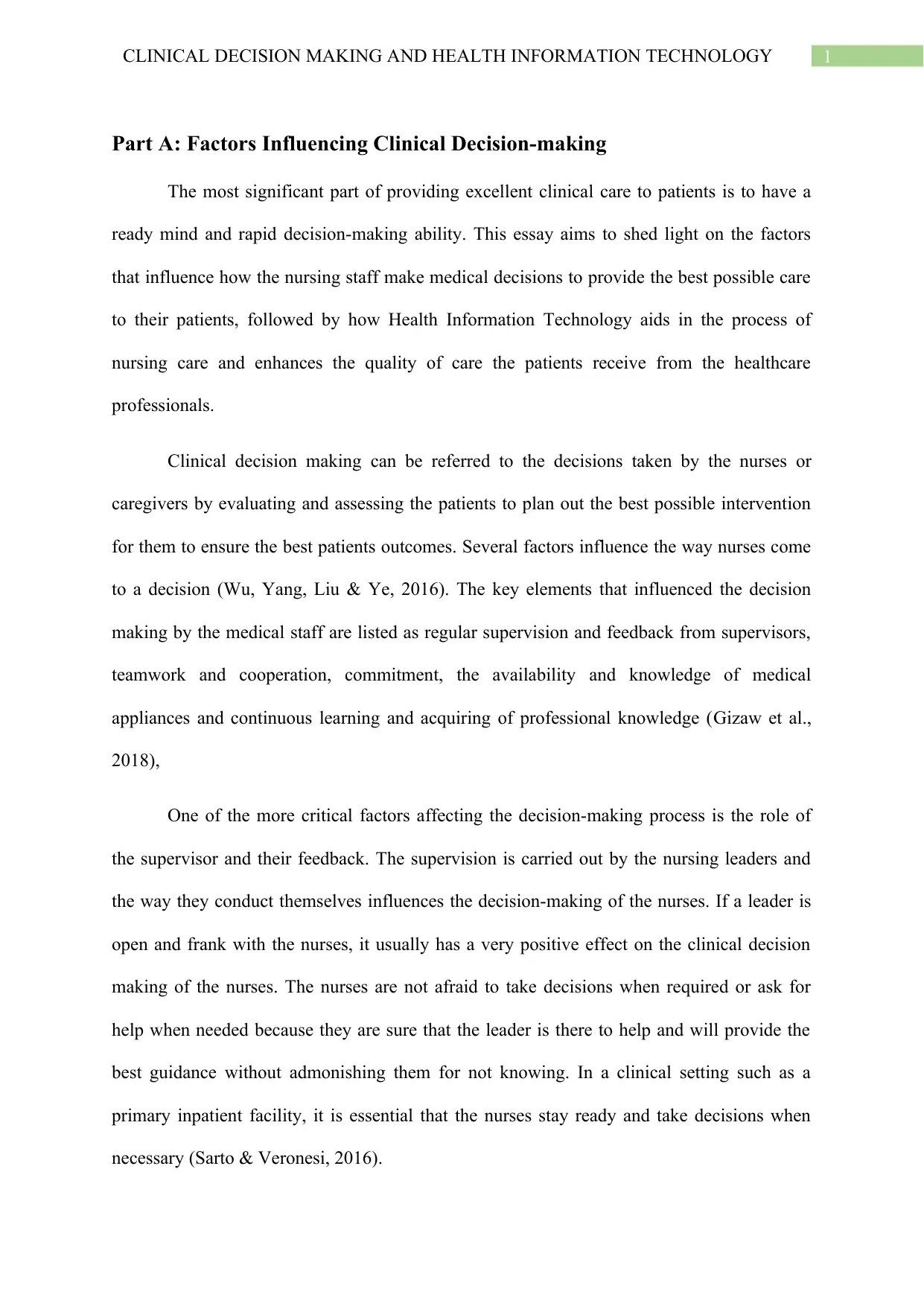
1CLINICAL DECISION MAKING AND HEALTH INFORMATION TECHNOLOGY
Part A: Factors Influencing Clinical Decision-making
The most significant part of providing excellent clinical care to patients is to have a
ready mind and rapid decision-making ability. This essay aims to shed light on the factors
that influence how the nursing staff make medical decisions to provide the best possible care
to their patients, followed by how Health Information Technology aids in the process of
nursing care and enhances the quality of care the patients receive from the healthcare
professionals.
Clinical decision making can be referred to the decisions taken by the nurses or
caregivers by evaluating and assessing the patients to plan out the best possible intervention
for them to ensure the best patients outcomes. Several factors influence the way nurses come
to a decision (Wu, Yang, Liu & Ye, 2016). The key elements that influenced the decision
making by the medical staff are listed as regular supervision and feedback from supervisors,
teamwork and cooperation, commitment, the availability and knowledge of medical
appliances and continuous learning and acquiring of professional knowledge (Gizaw et al.,
2018),
One of the more critical factors affecting the decision-making process is the role of
the supervisor and their feedback. The supervision is carried out by the nursing leaders and
the way they conduct themselves influences the decision-making of the nurses. If a leader is
open and frank with the nurses, it usually has a very positive effect on the clinical decision
making of the nurses. The nurses are not afraid to take decisions when required or ask for
help when needed because they are sure that the leader is there to help and will provide the
best guidance without admonishing them for not knowing. In a clinical setting such as a
primary inpatient facility, it is essential that the nurses stay ready and take decisions when
necessary (Sarto & Veronesi, 2016).
Part A: Factors Influencing Clinical Decision-making
The most significant part of providing excellent clinical care to patients is to have a
ready mind and rapid decision-making ability. This essay aims to shed light on the factors
that influence how the nursing staff make medical decisions to provide the best possible care
to their patients, followed by how Health Information Technology aids in the process of
nursing care and enhances the quality of care the patients receive from the healthcare
professionals.
Clinical decision making can be referred to the decisions taken by the nurses or
caregivers by evaluating and assessing the patients to plan out the best possible intervention
for them to ensure the best patients outcomes. Several factors influence the way nurses come
to a decision (Wu, Yang, Liu & Ye, 2016). The key elements that influenced the decision
making by the medical staff are listed as regular supervision and feedback from supervisors,
teamwork and cooperation, commitment, the availability and knowledge of medical
appliances and continuous learning and acquiring of professional knowledge (Gizaw et al.,
2018),
One of the more critical factors affecting the decision-making process is the role of
the supervisor and their feedback. The supervision is carried out by the nursing leaders and
the way they conduct themselves influences the decision-making of the nurses. If a leader is
open and frank with the nurses, it usually has a very positive effect on the clinical decision
making of the nurses. The nurses are not afraid to take decisions when required or ask for
help when needed because they are sure that the leader is there to help and will provide the
best guidance without admonishing them for not knowing. In a clinical setting such as a
primary inpatient facility, it is essential that the nurses stay ready and take decisions when
necessary (Sarto & Veronesi, 2016).
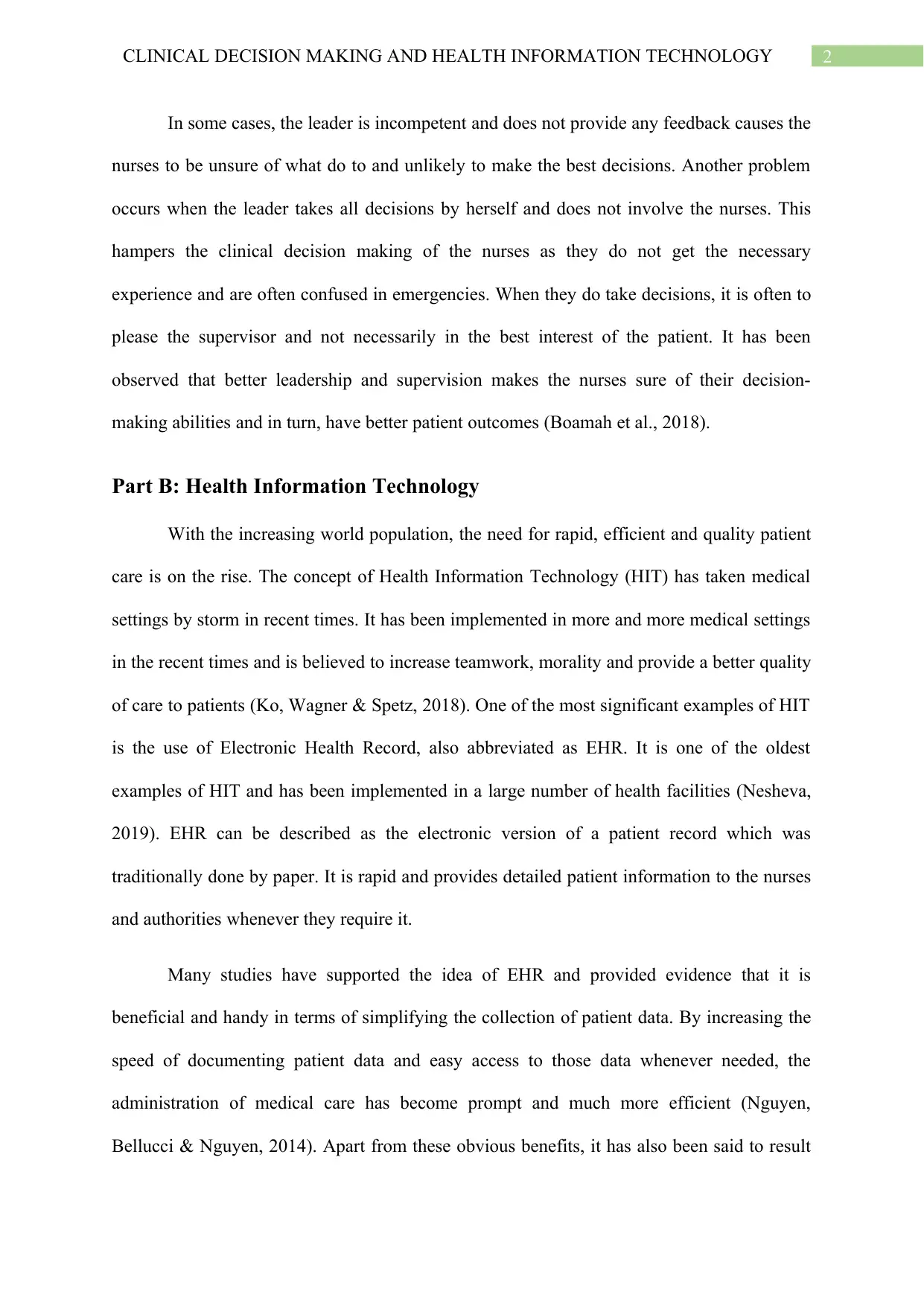
2CLINICAL DECISION MAKING AND HEALTH INFORMATION TECHNOLOGY
In some cases, the leader is incompetent and does not provide any feedback causes the
nurses to be unsure of what do to and unlikely to make the best decisions. Another problem
occurs when the leader takes all decisions by herself and does not involve the nurses. This
hampers the clinical decision making of the nurses as they do not get the necessary
experience and are often confused in emergencies. When they do take decisions, it is often to
please the supervisor and not necessarily in the best interest of the patient. It has been
observed that better leadership and supervision makes the nurses sure of their decision-
making abilities and in turn, have better patient outcomes (Boamah et al., 2018).
Part B: Health Information Technology
With the increasing world population, the need for rapid, efficient and quality patient
care is on the rise. The concept of Health Information Technology (HIT) has taken medical
settings by storm in recent times. It has been implemented in more and more medical settings
in the recent times and is believed to increase teamwork, morality and provide a better quality
of care to patients (Ko, Wagner & Spetz, 2018). One of the most significant examples of HIT
is the use of Electronic Health Record, also abbreviated as EHR. It is one of the oldest
examples of HIT and has been implemented in a large number of health facilities (Nesheva,
2019). EHR can be described as the electronic version of a patient record which was
traditionally done by paper. It is rapid and provides detailed patient information to the nurses
and authorities whenever they require it.
Many studies have supported the idea of EHR and provided evidence that it is
beneficial and handy in terms of simplifying the collection of patient data. By increasing the
speed of documenting patient data and easy access to those data whenever needed, the
administration of medical care has become prompt and much more efficient (Nguyen,
Bellucci & Nguyen, 2014). Apart from these obvious benefits, it has also been said to result
In some cases, the leader is incompetent and does not provide any feedback causes the
nurses to be unsure of what do to and unlikely to make the best decisions. Another problem
occurs when the leader takes all decisions by herself and does not involve the nurses. This
hampers the clinical decision making of the nurses as they do not get the necessary
experience and are often confused in emergencies. When they do take decisions, it is often to
please the supervisor and not necessarily in the best interest of the patient. It has been
observed that better leadership and supervision makes the nurses sure of their decision-
making abilities and in turn, have better patient outcomes (Boamah et al., 2018).
Part B: Health Information Technology
With the increasing world population, the need for rapid, efficient and quality patient
care is on the rise. The concept of Health Information Technology (HIT) has taken medical
settings by storm in recent times. It has been implemented in more and more medical settings
in the recent times and is believed to increase teamwork, morality and provide a better quality
of care to patients (Ko, Wagner & Spetz, 2018). One of the most significant examples of HIT
is the use of Electronic Health Record, also abbreviated as EHR. It is one of the oldest
examples of HIT and has been implemented in a large number of health facilities (Nesheva,
2019). EHR can be described as the electronic version of a patient record which was
traditionally done by paper. It is rapid and provides detailed patient information to the nurses
and authorities whenever they require it.
Many studies have supported the idea of EHR and provided evidence that it is
beneficial and handy in terms of simplifying the collection of patient data. By increasing the
speed of documenting patient data and easy access to those data whenever needed, the
administration of medical care has become prompt and much more efficient (Nguyen,
Bellucci & Nguyen, 2014). Apart from these obvious benefits, it has also been said to result
⊘ This is a preview!⊘
Do you want full access?
Subscribe today to unlock all pages.

Trusted by 1+ million students worldwide
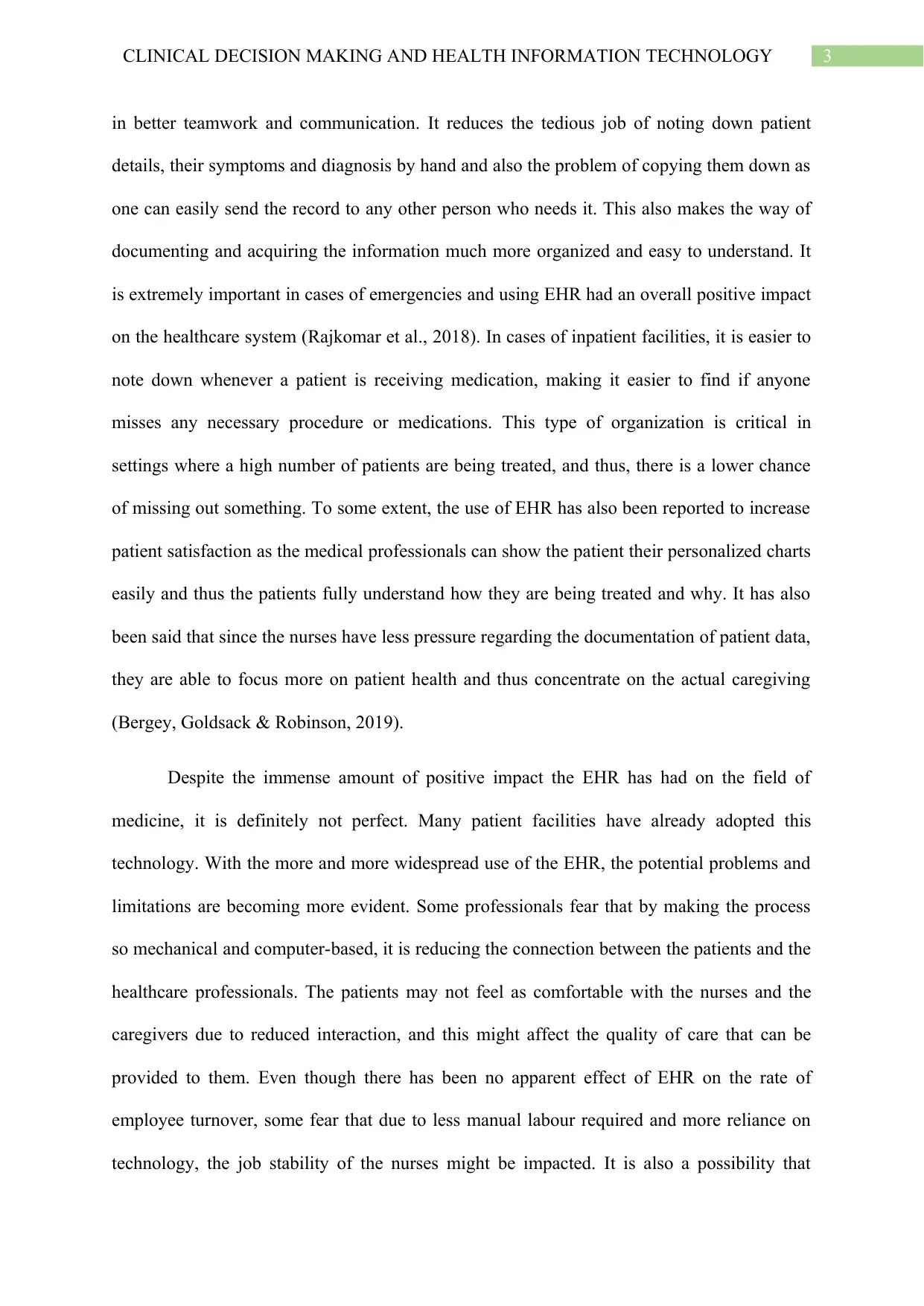
3CLINICAL DECISION MAKING AND HEALTH INFORMATION TECHNOLOGY
in better teamwork and communication. It reduces the tedious job of noting down patient
details, their symptoms and diagnosis by hand and also the problem of copying them down as
one can easily send the record to any other person who needs it. This also makes the way of
documenting and acquiring the information much more organized and easy to understand. It
is extremely important in cases of emergencies and using EHR had an overall positive impact
on the healthcare system (Rajkomar et al., 2018). In cases of inpatient facilities, it is easier to
note down whenever a patient is receiving medication, making it easier to find if anyone
misses any necessary procedure or medications. This type of organization is critical in
settings where a high number of patients are being treated, and thus, there is a lower chance
of missing out something. To some extent, the use of EHR has also been reported to increase
patient satisfaction as the medical professionals can show the patient their personalized charts
easily and thus the patients fully understand how they are being treated and why. It has also
been said that since the nurses have less pressure regarding the documentation of patient data,
they are able to focus more on patient health and thus concentrate on the actual caregiving
(Bergey, Goldsack & Robinson, 2019).
Despite the immense amount of positive impact the EHR has had on the field of
medicine, it is definitely not perfect. Many patient facilities have already adopted this
technology. With the more and more widespread use of the EHR, the potential problems and
limitations are becoming more evident. Some professionals fear that by making the process
so mechanical and computer-based, it is reducing the connection between the patients and the
healthcare professionals. The patients may not feel as comfortable with the nurses and the
caregivers due to reduced interaction, and this might affect the quality of care that can be
provided to them. Even though there has been no apparent effect of EHR on the rate of
employee turnover, some fear that due to less manual labour required and more reliance on
technology, the job stability of the nurses might be impacted. It is also a possibility that
in better teamwork and communication. It reduces the tedious job of noting down patient
details, their symptoms and diagnosis by hand and also the problem of copying them down as
one can easily send the record to any other person who needs it. This also makes the way of
documenting and acquiring the information much more organized and easy to understand. It
is extremely important in cases of emergencies and using EHR had an overall positive impact
on the healthcare system (Rajkomar et al., 2018). In cases of inpatient facilities, it is easier to
note down whenever a patient is receiving medication, making it easier to find if anyone
misses any necessary procedure or medications. This type of organization is critical in
settings where a high number of patients are being treated, and thus, there is a lower chance
of missing out something. To some extent, the use of EHR has also been reported to increase
patient satisfaction as the medical professionals can show the patient their personalized charts
easily and thus the patients fully understand how they are being treated and why. It has also
been said that since the nurses have less pressure regarding the documentation of patient data,
they are able to focus more on patient health and thus concentrate on the actual caregiving
(Bergey, Goldsack & Robinson, 2019).
Despite the immense amount of positive impact the EHR has had on the field of
medicine, it is definitely not perfect. Many patient facilities have already adopted this
technology. With the more and more widespread use of the EHR, the potential problems and
limitations are becoming more evident. Some professionals fear that by making the process
so mechanical and computer-based, it is reducing the connection between the patients and the
healthcare professionals. The patients may not feel as comfortable with the nurses and the
caregivers due to reduced interaction, and this might affect the quality of care that can be
provided to them. Even though there has been no apparent effect of EHR on the rate of
employee turnover, some fear that due to less manual labour required and more reliance on
technology, the job stability of the nurses might be impacted. It is also a possibility that
Paraphrase This Document
Need a fresh take? Get an instant paraphrase of this document with our AI Paraphraser
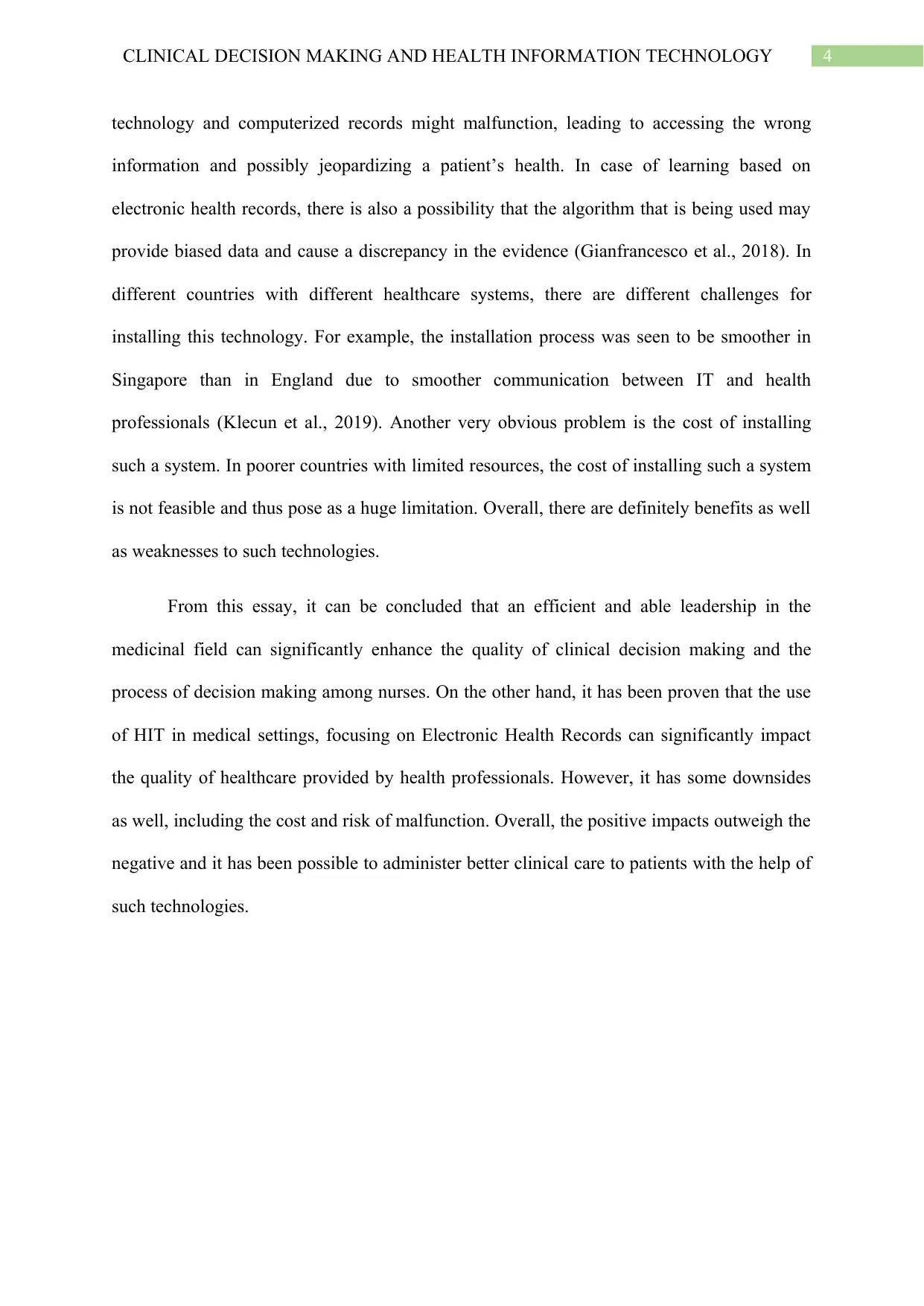
4CLINICAL DECISION MAKING AND HEALTH INFORMATION TECHNOLOGY
technology and computerized records might malfunction, leading to accessing the wrong
information and possibly jeopardizing a patient’s health. In case of learning based on
electronic health records, there is also a possibility that the algorithm that is being used may
provide biased data and cause a discrepancy in the evidence (Gianfrancesco et al., 2018). In
different countries with different healthcare systems, there are different challenges for
installing this technology. For example, the installation process was seen to be smoother in
Singapore than in England due to smoother communication between IT and health
professionals (Klecun et al., 2019). Another very obvious problem is the cost of installing
such a system. In poorer countries with limited resources, the cost of installing such a system
is not feasible and thus pose as a huge limitation. Overall, there are definitely benefits as well
as weaknesses to such technologies.
From this essay, it can be concluded that an efficient and able leadership in the
medicinal field can significantly enhance the quality of clinical decision making and the
process of decision making among nurses. On the other hand, it has been proven that the use
of HIT in medical settings, focusing on Electronic Health Records can significantly impact
the quality of healthcare provided by health professionals. However, it has some downsides
as well, including the cost and risk of malfunction. Overall, the positive impacts outweigh the
negative and it has been possible to administer better clinical care to patients with the help of
such technologies.
technology and computerized records might malfunction, leading to accessing the wrong
information and possibly jeopardizing a patient’s health. In case of learning based on
electronic health records, there is also a possibility that the algorithm that is being used may
provide biased data and cause a discrepancy in the evidence (Gianfrancesco et al., 2018). In
different countries with different healthcare systems, there are different challenges for
installing this technology. For example, the installation process was seen to be smoother in
Singapore than in England due to smoother communication between IT and health
professionals (Klecun et al., 2019). Another very obvious problem is the cost of installing
such a system. In poorer countries with limited resources, the cost of installing such a system
is not feasible and thus pose as a huge limitation. Overall, there are definitely benefits as well
as weaknesses to such technologies.
From this essay, it can be concluded that an efficient and able leadership in the
medicinal field can significantly enhance the quality of clinical decision making and the
process of decision making among nurses. On the other hand, it has been proven that the use
of HIT in medical settings, focusing on Electronic Health Records can significantly impact
the quality of healthcare provided by health professionals. However, it has some downsides
as well, including the cost and risk of malfunction. Overall, the positive impacts outweigh the
negative and it has been possible to administer better clinical care to patients with the help of
such technologies.
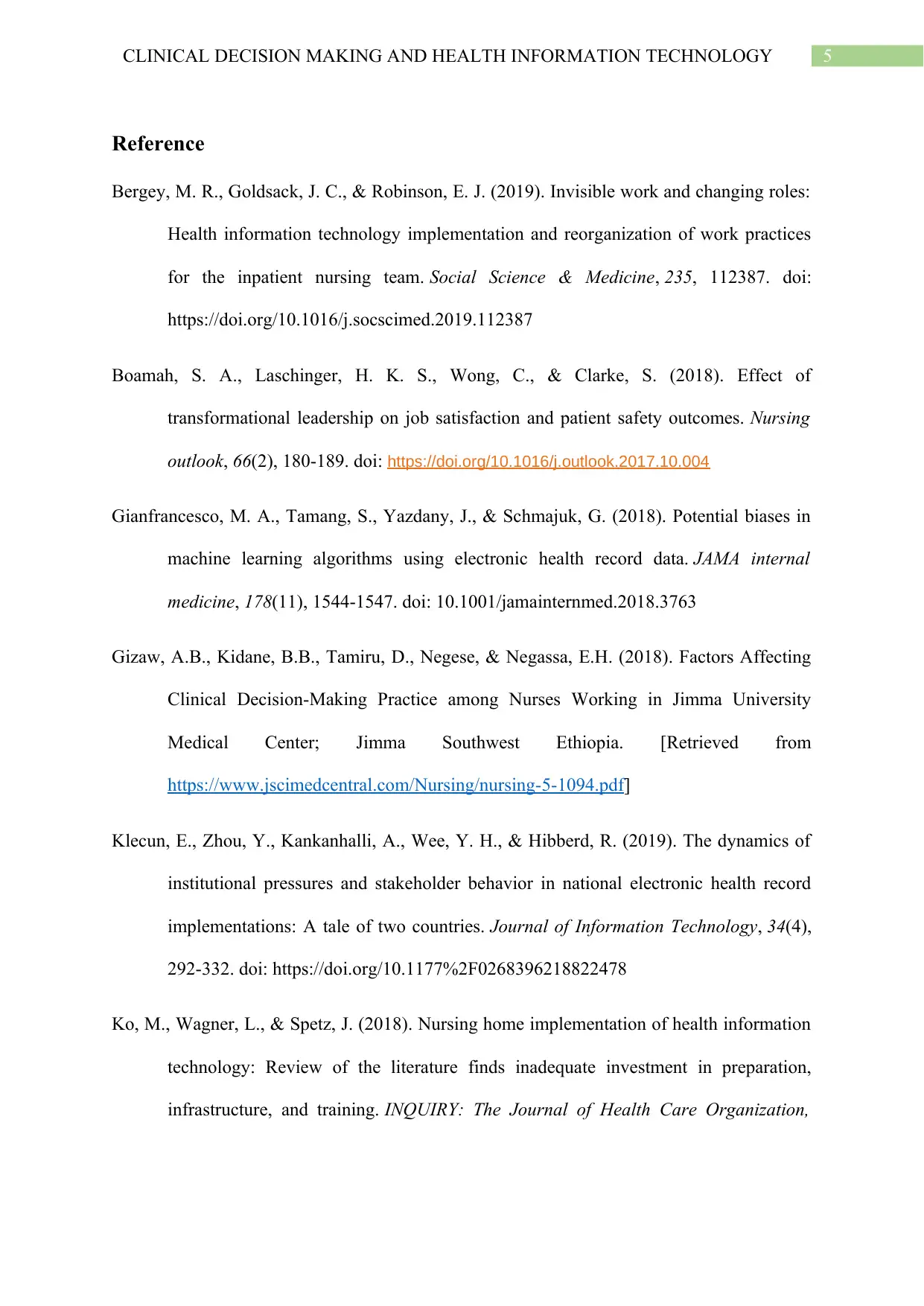
5CLINICAL DECISION MAKING AND HEALTH INFORMATION TECHNOLOGY
Reference
Bergey, M. R., Goldsack, J. C., & Robinson, E. J. (2019). Invisible work and changing roles:
Health information technology implementation and reorganization of work practices
for the inpatient nursing team. Social Science & Medicine, 235, 112387. doi:
https://doi.org/10.1016/j.socscimed.2019.112387
Boamah, S. A., Laschinger, H. K. S., Wong, C., & Clarke, S. (2018). Effect of
transformational leadership on job satisfaction and patient safety outcomes. Nursing
outlook, 66(2), 180-189. doi: https://doi.org/10.1016/j.outlook.2017.10.004
Gianfrancesco, M. A., Tamang, S., Yazdany, J., & Schmajuk, G. (2018). Potential biases in
machine learning algorithms using electronic health record data. JAMA internal
medicine, 178(11), 1544-1547. doi: 10.1001/jamainternmed.2018.3763
Gizaw, A.B., Kidane, B.B., Tamiru, D., Negese, & Negassa, E.H. (2018). Factors Affecting
Clinical Decision-Making Practice among Nurses Working in Jimma University
Medical Center; Jimma Southwest Ethiopia. [Retrieved from
https://www.jscimedcentral.com/Nursing/nursing-5-1094.pdf]
Klecun, E., Zhou, Y., Kankanhalli, A., Wee, Y. H., & Hibberd, R. (2019). The dynamics of
institutional pressures and stakeholder behavior in national electronic health record
implementations: A tale of two countries. Journal of Information Technology, 34(4),
292-332. doi: https://doi.org/10.1177%2F0268396218822478
Ko, M., Wagner, L., & Spetz, J. (2018). Nursing home implementation of health information
technology: Review of the literature finds inadequate investment in preparation,
infrastructure, and training. INQUIRY: The Journal of Health Care Organization,
Reference
Bergey, M. R., Goldsack, J. C., & Robinson, E. J. (2019). Invisible work and changing roles:
Health information technology implementation and reorganization of work practices
for the inpatient nursing team. Social Science & Medicine, 235, 112387. doi:
https://doi.org/10.1016/j.socscimed.2019.112387
Boamah, S. A., Laschinger, H. K. S., Wong, C., & Clarke, S. (2018). Effect of
transformational leadership on job satisfaction and patient safety outcomes. Nursing
outlook, 66(2), 180-189. doi: https://doi.org/10.1016/j.outlook.2017.10.004
Gianfrancesco, M. A., Tamang, S., Yazdany, J., & Schmajuk, G. (2018). Potential biases in
machine learning algorithms using electronic health record data. JAMA internal
medicine, 178(11), 1544-1547. doi: 10.1001/jamainternmed.2018.3763
Gizaw, A.B., Kidane, B.B., Tamiru, D., Negese, & Negassa, E.H. (2018). Factors Affecting
Clinical Decision-Making Practice among Nurses Working in Jimma University
Medical Center; Jimma Southwest Ethiopia. [Retrieved from
https://www.jscimedcentral.com/Nursing/nursing-5-1094.pdf]
Klecun, E., Zhou, Y., Kankanhalli, A., Wee, Y. H., & Hibberd, R. (2019). The dynamics of
institutional pressures and stakeholder behavior in national electronic health record
implementations: A tale of two countries. Journal of Information Technology, 34(4),
292-332. doi: https://doi.org/10.1177%2F0268396218822478
Ko, M., Wagner, L., & Spetz, J. (2018). Nursing home implementation of health information
technology: Review of the literature finds inadequate investment in preparation,
infrastructure, and training. INQUIRY: The Journal of Health Care Organization,
⊘ This is a preview!⊘
Do you want full access?
Subscribe today to unlock all pages.

Trusted by 1+ million students worldwide
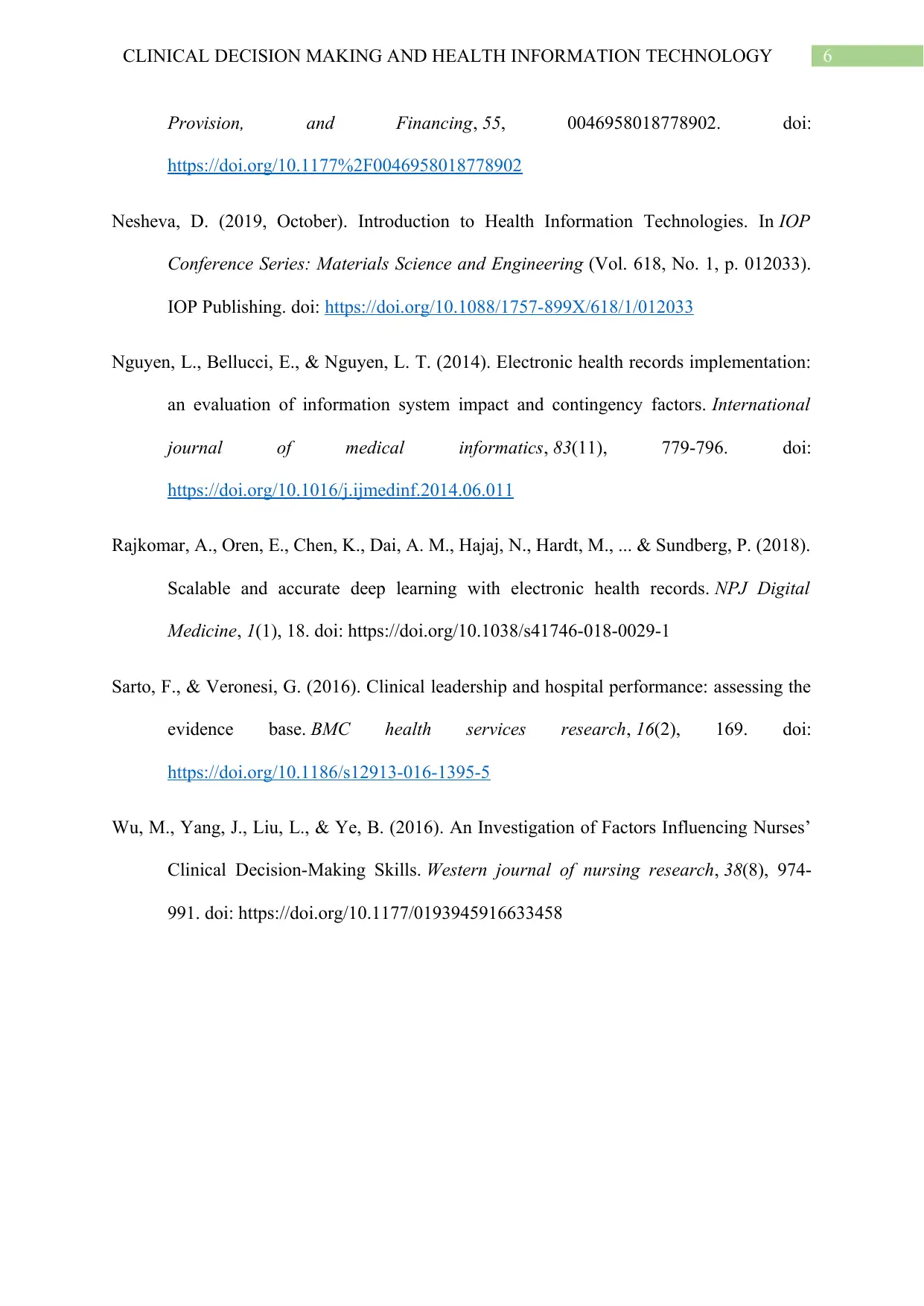
6CLINICAL DECISION MAKING AND HEALTH INFORMATION TECHNOLOGY
Provision, and Financing, 55, 0046958018778902. doi:
https://doi.org/10.1177%2F0046958018778902
Nesheva, D. (2019, October). Introduction to Health Information Technologies. In IOP
Conference Series: Materials Science and Engineering (Vol. 618, No. 1, p. 012033).
IOP Publishing. doi: https://doi.org/10.1088/1757-899X/618/1/012033
Nguyen, L., Bellucci, E., & Nguyen, L. T. (2014). Electronic health records implementation:
an evaluation of information system impact and contingency factors. International
journal of medical informatics, 83(11), 779-796. doi:
https://doi.org/10.1016/j.ijmedinf.2014.06.011
Rajkomar, A., Oren, E., Chen, K., Dai, A. M., Hajaj, N., Hardt, M., ... & Sundberg, P. (2018).
Scalable and accurate deep learning with electronic health records. NPJ Digital
Medicine, 1(1), 18. doi: https://doi.org/10.1038/s41746-018-0029-1
Sarto, F., & Veronesi, G. (2016). Clinical leadership and hospital performance: assessing the
evidence base. BMC health services research, 16(2), 169. doi:
https://doi.org/10.1186/s12913-016-1395-5
Wu, M., Yang, J., Liu, L., & Ye, B. (2016). An Investigation of Factors Influencing Nurses’
Clinical Decision-Making Skills. Western journal of nursing research, 38(8), 974-
991. doi: https://doi.org/10.1177/0193945916633458
Provision, and Financing, 55, 0046958018778902. doi:
https://doi.org/10.1177%2F0046958018778902
Nesheva, D. (2019, October). Introduction to Health Information Technologies. In IOP
Conference Series: Materials Science and Engineering (Vol. 618, No. 1, p. 012033).
IOP Publishing. doi: https://doi.org/10.1088/1757-899X/618/1/012033
Nguyen, L., Bellucci, E., & Nguyen, L. T. (2014). Electronic health records implementation:
an evaluation of information system impact and contingency factors. International
journal of medical informatics, 83(11), 779-796. doi:
https://doi.org/10.1016/j.ijmedinf.2014.06.011
Rajkomar, A., Oren, E., Chen, K., Dai, A. M., Hajaj, N., Hardt, M., ... & Sundberg, P. (2018).
Scalable and accurate deep learning with electronic health records. NPJ Digital
Medicine, 1(1), 18. doi: https://doi.org/10.1038/s41746-018-0029-1
Sarto, F., & Veronesi, G. (2016). Clinical leadership and hospital performance: assessing the
evidence base. BMC health services research, 16(2), 169. doi:
https://doi.org/10.1186/s12913-016-1395-5
Wu, M., Yang, J., Liu, L., & Ye, B. (2016). An Investigation of Factors Influencing Nurses’
Clinical Decision-Making Skills. Western journal of nursing research, 38(8), 974-
991. doi: https://doi.org/10.1177/0193945916633458
1 out of 7
Related Documents
Your All-in-One AI-Powered Toolkit for Academic Success.
+13062052269
info@desklib.com
Available 24*7 on WhatsApp / Email
![[object Object]](/_next/static/media/star-bottom.7253800d.svg)
Unlock your academic potential
Copyright © 2020–2025 A2Z Services. All Rights Reserved. Developed and managed by ZUCOL.





